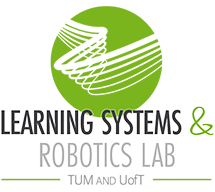The live session of the workshop is scheduled for 10:10 am -12:10 pm EDT (4:10 pm-6:10 pm CEST) September 27, 2021.
Overview
Robots are playing an increasingly important role in our lives. When deploying robots in the real world, safety of operation is an essential requirement. In the past, traditional perception, planning, and control techniques have been successfully applied to automate robots in static environments, where the dynamics of the robots are relatively well-characterized. However, with the continuously advancing capabilities of robots comes higher demands for safety. We expect robots to perform complex tasks in unstructured and dynamic environments, which requires robots to act safely despite uncertainties. In recent years, machine learning algorithms, especially reinforcement learning, have been developed to achieve complex tasks. However, safety and robustness considerations for these algorithms have been lacking till recently. As noted in the “Roadmap for US Robotics (2020)”, a key factor to enable next-generation robotics applications is safety, which is ingrained in all aspects of automation including perception, planning, and control. In this workshop, we bring together researchers from these fields to facilitate interdisciplinary discussions and initiate collaboration on the topic of safe autonomy for real-world applications. To this end, our workshop has four components: a tutorial on Safe Robot Autonomy and three moderated discussion sessions each addressing an important theme related to safe robot autonomy: (i) Safety Definitions and Requirements, (ii) Open Challenges and Opportunities for Integrating Theoretic and Data-driven Approaches, and (iii) Evaluation of Safety-Aware and Safety-Assured Algorithms. We envision this workshop to be an effort towards a long-term, interdisciplinary exchange on the development of safe real-world robotic systems.
Our workshop will include a tutorial covering our recent review paper on Safe Learning in Robotics, invited spotlight talks, as well as live panel discussions with experts in the field to share their perspectives on the three discussion themes. Post your questions or ideas using the form below and join our live session on September 27 (10:10 am EDT or 4:10 pm CEST)! We will have a social event at the end of the workshop. Join us here (password will be announced in the live session).
Program | Discussion Themes | Speakers | Invited Spotlight Talks | Organizers
Program
Pre-Recorded Components
Part A. Tutorial: Safe Learning in Robotics: From Learning-Based Control to Safe Reinforcement Learning
Part B. Spotlight Talks: Trends in Safe Learning for Robotics [video]
Live Session (September 27, 2021)
10:10–10:20 EDT | 16:10–16:20 CEST: Introduction
10:20–10:55 EDT | 16:20–16:55 CEST: Panel Discussion A – Safety Definitions and Requirements for Real-World Applications
10:55–11:30 EDT | 16:55–17:30 CEST: Panel Discussion B – Challenges and Opportunities to Leverage Theory and Data for Safety Assurance
11:30–12:05 EDT | 17:30–18:05 CEST: Panel Discussion C – Benchmarks and Performance Metrics for Safe Robot Autonomy
12:05–12:10 EDT | 18:05–18:10 CEST: Concluding Remarks
12:10–13:00 EDT | 18:10–19:00 CEST: Post-Workshop Social Event
The video of our live session is available at this link.
Discussion Themes
Panel A: Safety Definitions and Requirements for Real-World Applications
Panelists: Naira Hovakimyan, Ryan Gariepy, Marco Pavone, and Felix Berkenkamp
Moderators: Somil Bansal and SiQi Zhou
- How do you define “safety” in your work? What is the biggest challenge you face as you apply this definition for real-world applications?
- For the safety of modern robotic systems, do you think we should still think in terms of guarantees, or are there other aspects that are more desirable, such as efficiency and repeatability?
- What challenges should the safety community focus on for the next 5 years?
- Do you think it is desirable (or even possible) to define the safety for today’s real-world robotic systems in the same way as we have defined it traditionally for systems like aircraft? Why or why not?
Panel B: Challenges and Opportunities to Leverage Theory and Data for Safety Assurance
Panelists: Wei Chai, Karol Hausman, and Alex Herzog
Moderators: Animesh Garg and Melissa Greeff
- What are the key features of your problem space in your application (number of agents, dynamic obstacles, stochasticity, level of precision, perception environment conditions)?
- What limits or prevents you from using traditional control approaches in your application (what part of the problem space)?
- How do you define safety constraints in a high-dimensional real-world setting (with multiple agents/ competing objectives, in human-centred env, etc.)?
- What is the most interesting safety challenge in your application that has been solved and how? What is the next significant hurdle/bottleneck to safety in your application?
- How do you identify corner cases in your application? What do you do when you enter a corner case? Can you give an example in your application?
Panel C: Benchmarks and Performance Metrics for Safe Robot Autonomy
Panelists: Vincent Vanhoucke, Anirudha Majumdar, and Byron Boots
Moderators: Angela Schoellig and SiQi Zhou
- What are some common benchmarks that are used in the robotics community? How do we measure “safety” and establish fair comparisons?
- What are the practical issues faced in real-world robotics applications, which are lacking in current benchmarks? What factors or aspects should be further emphasized to guide algorithm design for real-world autonomy?
- How do we move forward to maximize the accessibility of robot platforms to facilitate the transition from simulation environments to physical systems?
Use this link if the form is not displaying or upvoting is not working properly.
Speakers
Invited Spotlight Talks
Kim Wabersich, Predictive Safety Filters for Learning-based Control of Constrained Dynamical Systems [talk]
Aditya Gahlawat, Safe Learning-based Control via L1-Adaptive Control, Contraction Analysis, and Machine Learning [talk]
Ugo Rosolia, Learning How to Autonomously Race a Car: A Predictive Control Approach [talk]
Jason Choi, Data-Driven Methods for Safety Control Under Model Uncertainty [talk]
Sydney Katz, Verification of Image-Based Neural Network Controllers [talk]
Michael Everett, Certifiably Robust Deep Reinforcement Learning [talk]
Guanya Shi, Neural-Lander Family: Learning-Based Stable and Adaptive Control in Challenging Environments [talk]
Homanga Bharadhwaj, Conservative Safety Critics for Exploration [talk]
Organizers
Organizers Short Bio
Angela Schoellig | schoellig@utias.utoronto.ca
Angela Schoellig is an Associate Professor at the University of Toronto Institute for Aerospace Studies (UTIAS), where she heads the Dynamic Systems Lab. She is also a Faculty Member of the Vector Institute and an Associate Director of the Center for Aerial Robotics Research and Education (CARRE) at the University of Toronto. With her team, she conducts research at the interface of robotics, controls and machine learning. Her goal is to enhance the performance and autonomy of robots by enabling them to learn from past experiments and from each other.
Animesh Garg | garg@cs.toronto.edu
Animesh Garg is an Assistant Professor of Computer Science at the University of Toronto and a Faculty Member at the Vector Institute. He leads the UofT People, AI and Robotics (PAIR) group. The research of his group focuses on understanding structured inductive biases and causality on a quest for general-purpose embodied intelligence that learns from imprecise information and achieves flexibility and efficiency of human reasoning.
Somil Bansal | somil@eecs.berkeley.edu
Somil Bansal is joining the University of Southern California as an Assistant Professor in Fall 2021. He was formerly a Research Scientist at Waymo. His research interests include developing mathematical tools and algorithms for control and analysis of autonomous systems, with a focus on bridging learning and control-theoretic approaches for safety-critical autonomous systems.
Melissa Greeff | melissa.greeff@robotics.utias.utoronto.ca
Melissa Greeff is a PhD Candidate at the Dynamic Systems Lab, University of Toronto Institute for Aerospace Studies (UTIAS) and a student affiliate of the Vector Institute, Toronto, Canada. Her research interests include learning-based control for differentially flat systems and vision-based path-following control for UAVs during GPS-denied flight.
SiQi Zhou | siqi.zhou@robotics.utias.utoronto.ca
SiQi Zhou is a PhD Candidate at the Dynamic Systems Lab, University of Toronto Institute for Aerospace Studies (UTIAS) and a student affiliate of the Vector Institute, Toronto, Canada. Her research focuses on deep learning approaches that safely enhance the performance of autonomous robots.















